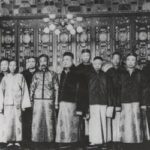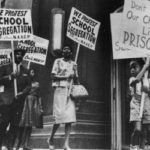In its first constitutional challenge to the equal protection clause of the Fourteenth Amendment, the U.S. Supreme Court decided to hear a case brought by a Chinese immigrant, not an American citizen. Yick Wo believed city ordinances had been unfairly applied to him, so he challenged their constitutionality under the equal protection clause, and took his case all the way to the Supreme Court.
Dialogue on the Fourteenth Amendment
The American Bar Association Dialogue program provides lawyers, judges and teachers with the resources they need to engage students and community members in a discussion of fundamental American legal principles and civic traditions. This Dialogue on the Fourteenth Amendment is composed of three parts:
Part 1: Equal Protection and Civil Rights – Participants discuss the equal protection clause of the 14th Amendment and consider how Congress, through federal legislation, has worked to help realize its constitutional promise.
Part 2: Incorporating the Bill of Rights examines the concept of incorporation. Using a case study of Gitlow v. New York, this section provides a guide to how courts have applied the Bill of Rights, selectively, to the states using the 14th Amendment.
Part 3: Ensuring Equality and Liberty explores how the 14th Amendment has been interpreted by courts to protect fundamental freedoms, including individuals’ right to marry.
Equal Protection Under Law
In this lesson, students will analyze the Fourteenth Amendment’s Equal Protection clause. They will distinguish between identical treatment and equal treatment under the law, and discuss situations in which discrimination is acceptable – not letting a 6-year-old obtain a driver’s license, for example.
The 14th Amendment and the Evolution of Title IX
Congress and the courts have applied the 14th Amendment’s equal protection clause to many aspects of public life over the past 150 years. In this activity, students will explore the evolution of the 14th Amendment through the lens of Title IX, which prohibits institutions that receive federal funding from excluding students from participating in educational and athletic programs on the basis of sex. The Supreme Court’s first Title IX case, Grove City College v. Bell, also demonstrates how each of the three branches exercises its authority.
Yick Wo and the Equal Protection Clause

This documentary examines the case Yick Wo v. Hopkins (1886) in which the Supreme Court held that noncitizens have due process rights under the Fourteenth Amendment’s equal protection clause. A PDF lesson plan accompanies the video. The video A Conversation on the Importance of the Yick Wo Case complements the documentary.
Equal Protection: What Is Discrimination?
What is the purpose of the equal protection clause? What did Plessy v. Ferguson and Brown v. Board of Education say? What are two ways of understanding the clause? This video lecture is part of an online course taught by University of Pennsylvania law professor Kermit Roosevelt III. “Introduction to Key Constitutional Concepts and Supreme Court Cases” covers the topics: Where does the Constitution come from? How has it changed over the years? How do we know what it means?
The Pursuit of Justice
The Pursuit of Justice book, written by Kermit L. Hall and John J. Patrick, analyzes 30 Supreme Court cases chosen by a group of Supreme Court justices and leading civics educators as the most important for American citizens to understand. An additional 100 significant cases included in state history and civics standards are summarized. The complete book or individuals chapters can be downloaded.
Constitutional Index – Amendment 14 State Equal Protection Clause
The Constitutional Index breaks down the U.S. Constitution by Section, Amendment, and Clause and contains broader topics and themes. These are used to cross-reference Library resources in an effort to annotate constitutional history.
The Power of One Decision: Brown v. Board of Education

When minority students decided to take their challenge of the “separate but equal” doctrine to the Supreme Court, the 1954 decision handed down by the court in Brown v. Board of Education and enforced by the executive branch, changed their lives and America forever. In this lesson plan, based on the Annenberg Classroom video “A Conversation on the Constitution: Brown v. Board of Education,” students gain insight into decision-making at the Supreme Court, learn about the people behind the case, construct a persuasive argument, and evaluate the significance of Brown v. Board of Education.
Shaw v. Reno (1993)
Did the North Carolina residents’ claim that the 1990 redistricting plan discriminated on the basis of race raise a valid constitutional issue under the 14th Amendment’s Equal Protection Clause? North Carolina drew legislative districts to create a majority black district.